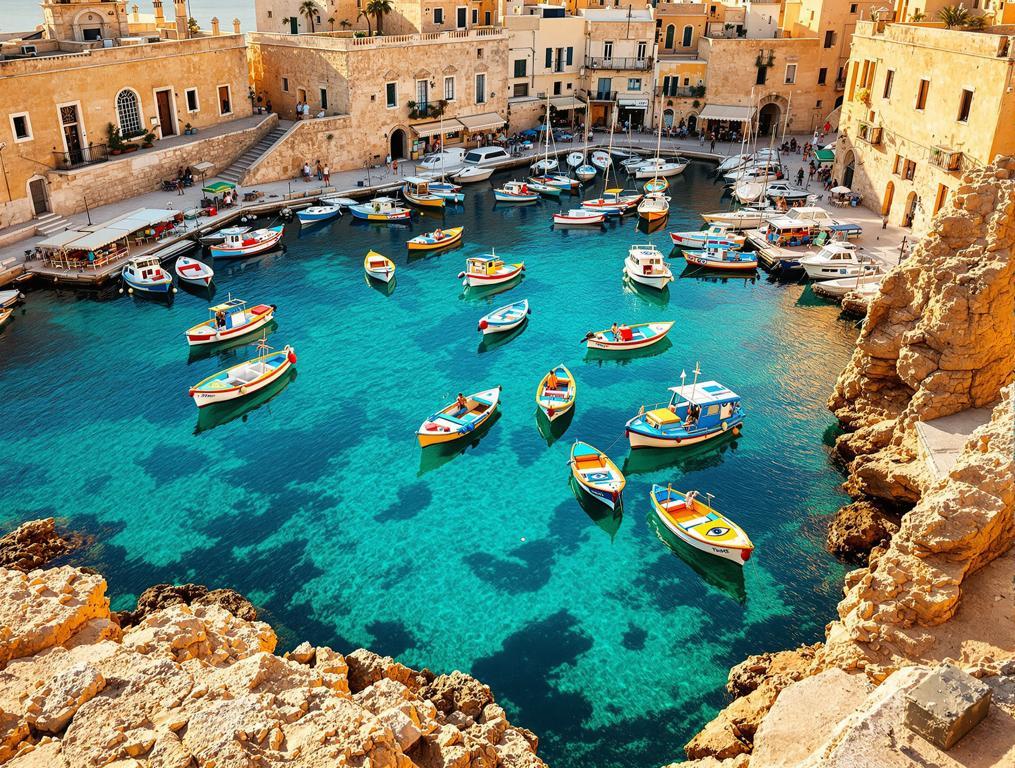The luzzu boats of Marsaxlokk sway gently in the harbor as I walk along the promenade at dawn. Their vibrant blues, yellows, and reds create a photographer’s dream against the backdrop of this fishing village of just 4,145 residents. But don’t let the size fool you – I’m standing on shores where 40,000 Ottoman troops once landed during the Great Siege of Malta in 1565, forever changing European history. My family and I have visited Malta’s popular spots like Valletta and Mdina, but this tiny harbor village offers something those tourist magnets can’t – authenticity that spans millennia.
Where Phoenician Eyes Still Watch Over Modern Fishermen
The harbor buzzes with activity as fishermen prepare their traditional luzzu boats for the day’s catch. Each vessel bears the distinctive Eye of Osiris on its bow – a tradition dating back to Phoenician times, believed to protect sailors from evil spirits.
“This isn’t just decoration,” explains a weather-beaten fisherman sorting his nets. “Without the eye, the boat is blind. We wouldn’t dare go to sea without it.”
These brightly colored vessels aren’t museum pieces; they’re working boats used daily, many owned by families who have fished these waters for generations. The boats’ color schemes aren’t random either – blue represents protection, red symbolizes courage, yellow honors the sun, and green celebrates nature.
“Everyone talks about Valletta and Gozo, but Marsaxlokk is where you’ll find Malta’s soul. Here, our traditions aren’t performances for tourists – they’re our daily life.”
What makes this village special is how it balances its historical significance with everyday life. Unlike medieval French villages that sometimes feel preserved primarily for tourism, Marsaxlokk maintains its working character while honoring traditions that stretch back centuries.
From Ottoman Invasions to Sunday Fish Markets
The peaceful harbor before me bears little resemblance to its tumultuous past. In 1565, these shores witnessed one of history’s pivotal moments when Ottoman forces landed during the Great Siege of Malta. Like Gorée Island off Senegal, Marsaxlokk’s small size belies its outsized historical importance.
Today, the village’s rhythm centers around its famous Sunday fish market, where vendors begin setting up at 5:00 AM. For the best experience, arrive before 9:00 AM when tourist buses appear. The weekday markets offer better prices and fewer crowds.
Walking through the stalls, I spot fishermen selling lampuki (dolphinfish), a local specialty available from August through December. The village’s culinary heritage shines in dishes like lampuki pie, where the fish is baked with capers, olives, and tomatoes in a flaky crust.
While some Indian islands offer authentic experiences without Maldives-level tourism, Marsaxlokk provides genuine Maltese culture without the crush of visitors you’ll find in Valletta.
What the Guidebooks Won’t Tell You
For swimming, skip the harbor and head to St. Peter’s Pool, a natural swimming area just 10 minutes by car from the village center. Unlike Colombia’s protected beaches, this local spot offers crystal-clear waters without massive crowds, especially on weekday mornings.
The Festa of Our Lady of the Assumption in July/August transforms the village with processions, fireworks, and communal feasts. Book accommodation at least three months ahead if visiting during this period.
For lunch, avoid the obvious tourist traps along the main promenade. Instead, try Tartarun Restaurant on Xatt is-Sajjieda for authentic aljotta (fish soup) or head to Tas-Sajjied Café for morning coffee and pastries.
Photography enthusiasts should arrive for golden hour (around 6:30 AM in summer) when the harbor’s colors intensify and fishermen prepare their boats – a scene largely missed by day-trippers arriving mid-morning.
Between History and Horizon
As the sun climbs higher, I watch my wife Sarah photograph an elderly man mending nets beside his luzzu. Our daughter Emma has already befriended local children playing near the water. This village exists in a delicate balance – one foot anchored in traditions thousands of years old, the other stepping cautiously into tourism’s future.
The Maltese have a saying: “Il-baħar jaf jistenna” – the sea knows how to wait. Standing on these ancient shores where Phoenicians, Romans, Knights, and Ottomans once stood, I can’t help but feel Marsaxlokk understands this patience too, revealing its treasures only to those willing to look beyond the obvious.
